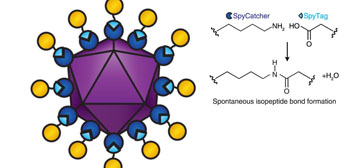Tag Team Combination Simplifies Vaccine Development
By LabMedica International staff writers
Posted on 03 Feb 2016
Vaccine development is simplified when a highly immunogenic virus-like particle (VLP) carrier is tagged with a genetically-encoded protein designed to spontaneously form a covalent bond to its antigen-labeled peptide-partner.Posted on 03 Feb 2016
Virus-like particles (VLPs) are noninfectious self-assembling nanoparticles, useful in medicine and nanotechnology. Their repetitive molecularly-defined architecture is attractive for engineering multivalency, notably for vaccination. VLPs contain repetitive high density displays of viral surface proteins, which present conformational viral epitopes that can elicit strong T-cell and B-cell immune responses. Additionally, since VLPs cannot replicate, they provide a safer alternative to attenuated viruses. VLPs have already been used to develop [US] Food and Drug Administration-approved vaccines for hepatitis B and human papillomavirus.

Image: Diagram of a viral vectored vaccine built using the SpyCatcher/ Tag combination. SpyCatcher (dark blue) is fused to the virus-like particle (purple). SpyTag (light blue) is fused to antigens (yellow). When SpyTag forms an isopeptide bond with SpyCatcher (diagram right), the antigens are attached to the virus-like particle (Photo courtesy of the University of Oxford).
Adapting VLPs for vaccine development requires the attachment of target antigens by either genetic fusion or chemical modification. Both approaches are time-consuming and often lead to capsids being misassembled or antigens being misfolded, which hinders generation of protective immunity.
To avoid these problems investigators at Oxford University (United Kingdom) established a platform for irreversibly decorating VLPs simply by mixing with protein antigen. SpyCatcher is an engineered protein domain which specifically recognizes and covalently bonds to a thirteen amino acid peptide tag (SpyTag). The SpyCatcher protein was engineered from a single domain of the fibronectin-binding protein FbaB from Streptococcus pyogenes, which naturally forms an internal isopeptide bond between a lysine and aspartate. Such bonds are well studied and, and are likely common in nature—specifically among Gram-positive bacteria. These isopeptide bonds have proven to be stable over a wide range of pH, temperatures, redox environments, and detergents. Thus, the SpyCatcher technology has found great utility in a number of applications, including the generation of bioactive hydrogels, catalytic biofilms, and thermostable proteins.
In the current study, the investigators expressed VLPs from the bacteriophage AP205 genetically fused to SpyCatcher in E. coli bacteria. They reported in the January 19, 2016, online edition of the journal Scientific Reports that they then demonstrated quantitative covalent coupling to the SpyCatcher-VLPs after mixing with SpyTag-linked to malaria antigens, including CIDR and Pfs25. Injecting SpyCatcher-VLPs decorated with a malarial antigen into mice efficiently induced antibody responses after only a single immunization.
In addition, the investigators demonstrated VLP coupling to cancer-relevant peptides from epidermal growth factor receptor and telomerase.
First author Dr. Karl Brune, a doctoral researcher at Oxford University, said, "Current techniques to develop VLP-based vaccines take time and do not always work. Whilst getting the pathogen parts to stick to the carrier VLP, often problems such as misassembly or misfolding arise that make the vaccine ineffective at generating protective immunity. We tested the SpyCatcher-VLP - SpyTag-antigen combination using a range of malarial and cancer-relevant antigens. This showed that linking can be done simply and quickly to produce stable vaccines that generated robust antibody responses."
Related Links:
Oxford University













